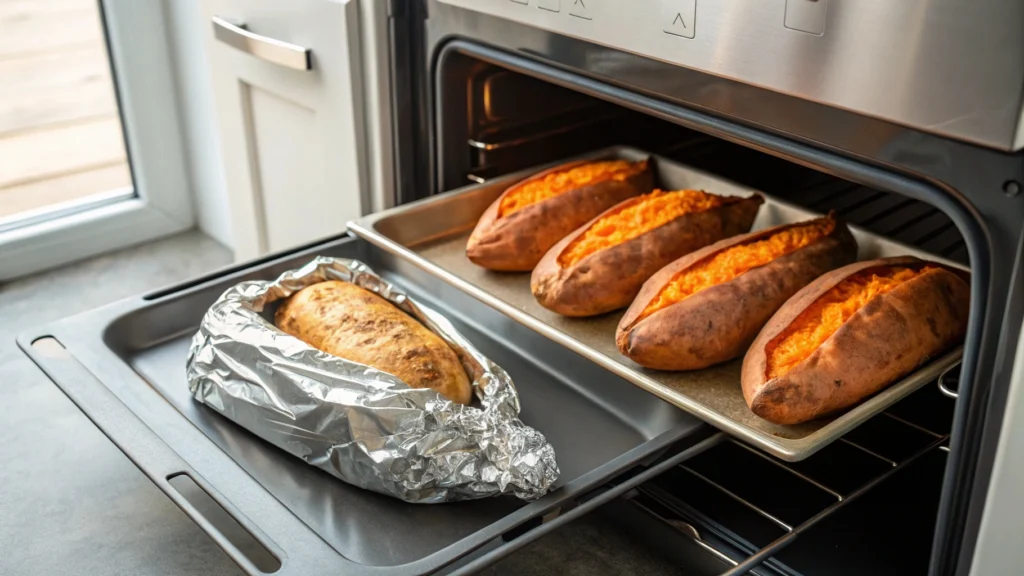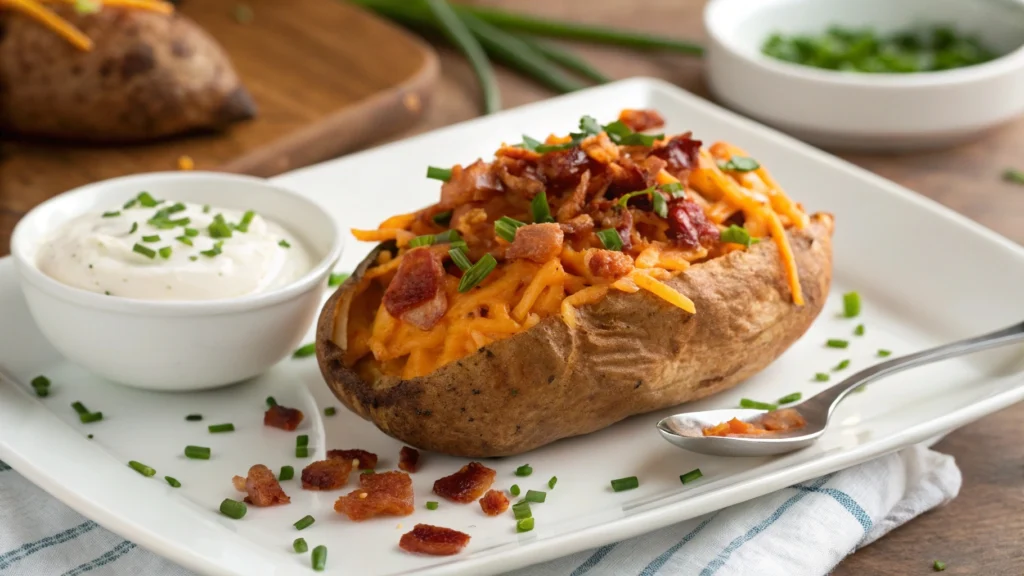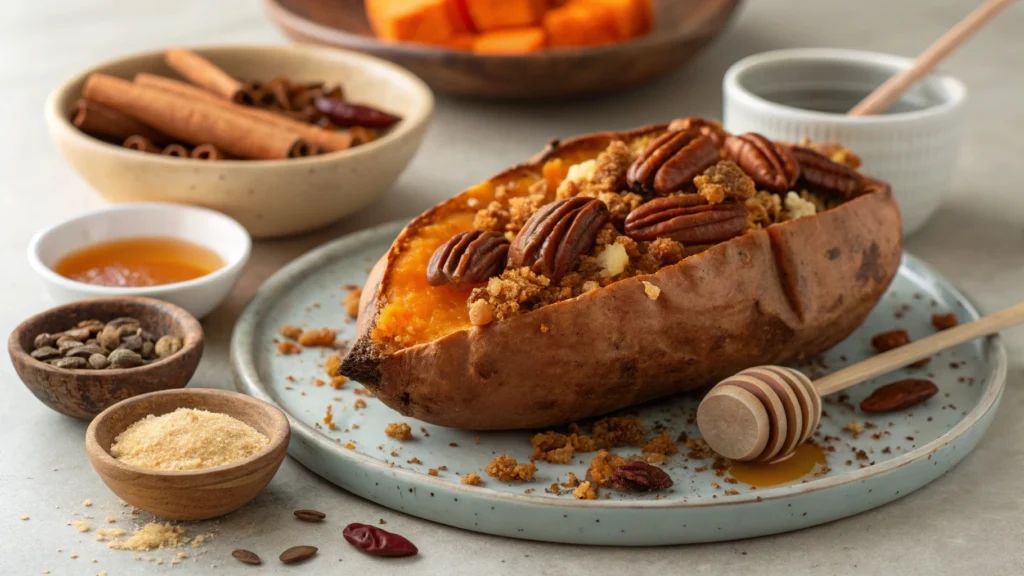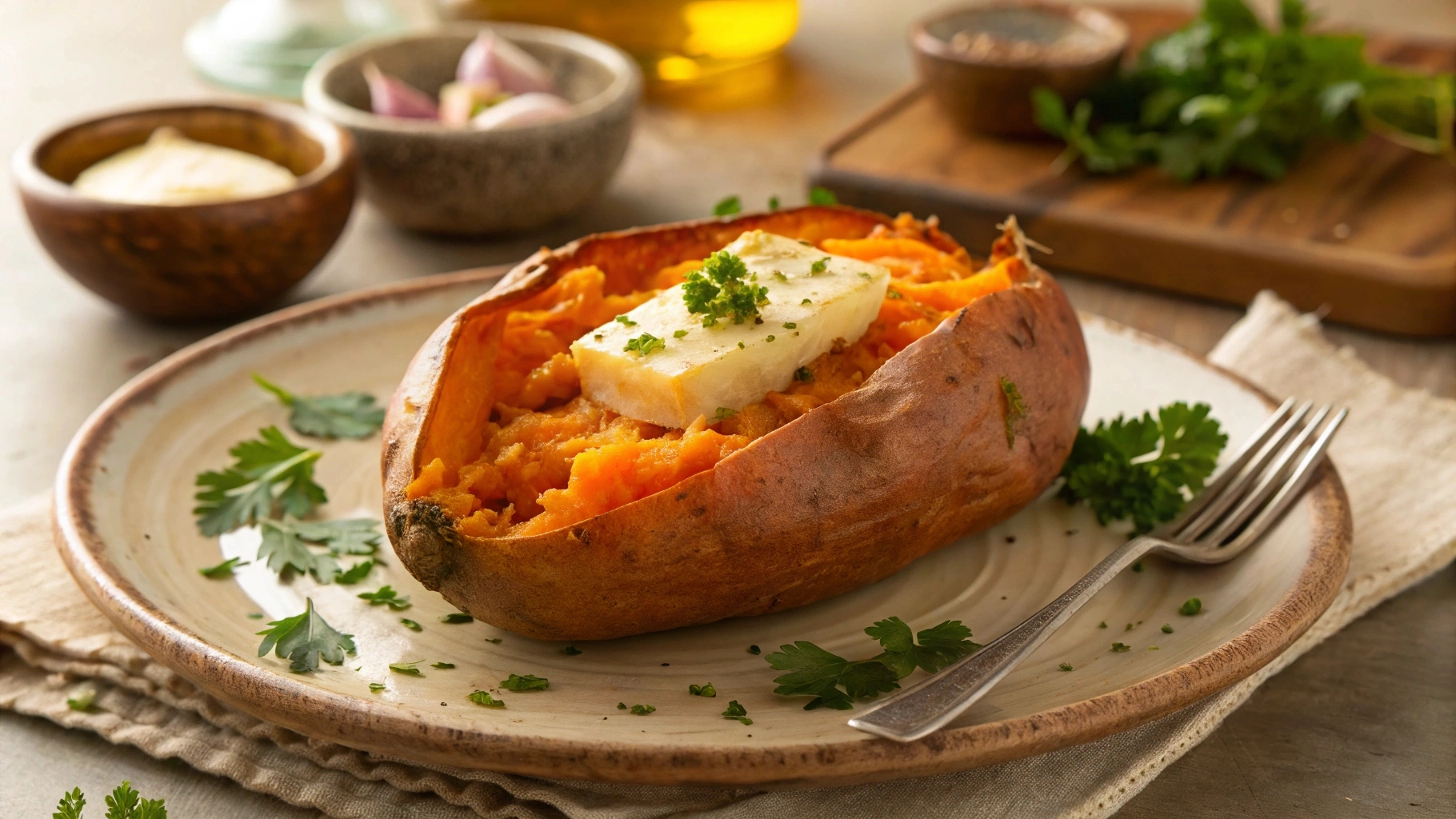Table of Contents
Sweet potatoes are a kitchen favorite, loved for their natural sweetness, creamy texture, and versatility. Among the many ways to prepare them, baking is perhaps the easiest and most delicious. With a few simple steps, you can transform this humble root vegetable into a comforting side dish or a show-stopping main course. In this guide, we’ll dive deep into everything you need to know about baked sweet potatoes—from preparation to baking techniques, flavor pairings, and even common mistakes to avoid. Whether you’re a seasoned cook or just starting out, this article has all the tips and tricks to elevate your sweet potato game.
Introduction to Baked Sweet Potatoes
Why Baked Sweet Potatoes Are a Popular Choice
There’s something magical about the simplicity of baked sweet potatoes. Unlike other cooking methods, baking enhances their natural sugars, giving them a rich caramelized flavor and a soft, fluffy texture. They’re incredibly versatile—perfect for quick weeknight dinners or as a healthier alternative to traditional comfort foods.
Moreover, baked sweet potatoes are a breeze to prepare. With minimal effort and a handful of ingredients, you can whip up a dish that’s nutritious and bursting with flavor. It’s no wonder they’ve become a staple in kitchens worldwide.
The Unique Flavor and Nutrition of Sweet Potatoes
Sweet potatoes are not only delicious but moreover pressed with nutrients. They’re rich in:
- Vitamins: Especially vitamin A, which supports eye health.
- Fiber: Promotes digestion and keeps you feeling full longer.
- Antioxidants: Help combat inflammation and boost immunity.
Their naturally sweet flavor pairs well with both savory and sweet toppings, making them a versatile ingredient in countless recipes.
How Baked Sweet Potatoes Fit Into Various Diets
Whether you’re following a paleo, vegan, gluten-free, or low-calorie diet, baked sweet potatoes fit seamlessly into your meal plan. They’re naturally gluten-free and low in fat, making them a guilt-free indulgence. Additionally, they serve as an excellent base for creative toppings, from roasted chickpeas to nut butter and granola.
Preparing Sweet Potatoes for Baking
Should You Peel Sweet Potatoes Before Baking?
Deciding whether to peel baked sweet potatoes depends on personal preference and the recipe. The skin contains fiber and nutrients, but some people prefer the smoother texture of peeled sweet potatoes.
- Keep the Skin On: If you want a more rustic presentation and extra fiber.
- Peel Them: If you’re using the sweet potatoes for a mash or smoother texture.
Regardless of your choice, be sure to wash and scrub the sweet potatoes thoroughly.
The Importance of Washing and Scrubbing Sweet Potatoes
Sweet potatoes grow in the soil, so they often carry dirt and debris. A quick rinse might not be enough to remove all particles.
- Rinse Under Running Water: Use a scrub brush to clean the skin gently.
- Dry Properly: Pat them dry with a clean kitchen towel to prevent sogginess while baking.
Clean sweet potatoes not only look more appealing but also ensure you don’t end up with grit in your dish.
Why You Should Poke Holes in Sweet Potatoes Before Baking
Poking holes is a small step that makes a big difference when baking sweet potatoes.
- Prevents Steam Build-Up: Sweet potatoes are dense, and the trapped steam can cause them to burst in the oven.
- Ensures Even Cooking: Poking holes allows heat to penetrate better, leading to a perfectly baked sweet potato.
Use a fork to pierce the skin a few times, ensuring the steam has a way to escape.
Baking Techniques for Sweet Potatoes
Foil or No Foil? Which Method is Better?

When it comes to baking sweet potatoes, the debate over using foil is common.
- Foil Method: Wrapping sweet potatoes in foil traps steam, making the skin softer. This is ideal if you plan to mash them or eat them skinless.
- No Foil: Baking without foil allows the skin to crisp up, perfect for those who enjoy a more textured, flavorful skin.
For a versatile option, bake them without foil and add foil during the last 10 minutes if you want a softer skin.
Step-by-Step Guide to Baking Sweet Potatoes Perfectly
- Preheat Your Oven: Set it to 400°F (200°C) for a balance of speed and even cooking.
- Prepare the Sweet Potatoes: Wash, dry, and poke holes in the skin.
- Season or Leave Plain: Lightly coat with olive oil and sprinkle with salt for a savory twist, or leave them plain for a classic bake.
- Bake: Place them on a baking sheet lined with parchment paper for easy cleanup. Bake for 45–60 minutes, depending on the size of potatoes.
- Check for Doneness: Insert a fork or knife into the thickest part—it should slide in easily.
How to Achieve a Crispy Skin and Soft Inside
To get that perfect combination of textures:
- Use High Heat: Baking at 400°F or higher caramelizes the natural sugars in sweet potatoes.
- Add Oil: A light brush of oil enhances the crispiness of the skin.
- Broil at the End: Broil for the last 3–5 minutes to give the skin extra crunch.
By following these techniques, you’ll achieve baked sweet potatoes that are as delicious as they are nutritious.
Flavor Variations and Toppings for Baked Sweet Potatoes
Savory Toppings: Cheese, Herbs, and Spices

Baked sweet potatoes shine when paired with savory toppings that balance their natural sweetness. Here are a few thoughts to try:
- Cheese: Sprinkle shredded cheddar, crumbled feta, or Parmesan for a creamy, salty contrast.
- Herbs: Fresh rosemary, thyme, or parsley add a fragrant touch.
- Spices: A dash of smoked paprika, cumin, or garlic powder enhances the depth of flavor.
For an extra layer of indulgence, drizzle a bit of sour cream or Greek yogurt over the toppings.
Sweet Toppings: Cinnamon, Maple Syrup, and Nuts

If you prefer a dessert-like dish, sweet toppings transform baked sweet potatoes into a decadent treat.
- Cinnamon and Sugar: Dust the baked potato with cinnamon and brown sugar for a classic combination.
- Maple Syrup: A light drizzle of maple syrup adds warmth and sweetness.
- Crunchy Nuts: Top with chopped pecans, walnuts, or almonds for texture and richness.
These toppings make sweet potatoes the perfect ending to a meal—or even a dessert in their own right.
Healthy Topping Ideas for Baked Sweet Potatoes
For a wholesome twist, keep your toppings simple and nutritious:
- Avocado and Salsa: A fresh and zesty combination that works as a meal on its own.
- Hummus: Spread a layer of hummus and sprinkle with chickpeas for added protein.
- Lemon and Herbs: A squeeze of lemon juice and a sprinkle of fresh parsley keep things light and refreshing.
These options ensure your sweet potatoes are both delicious and aligned with your health goals.
Serving Suggestions and Meal Pairings
How to Utilize Baked Sweet Potatoes as a Side Dish
Baked sweet potatoes are an excellent side dish that pairs well with a variety of main courses. Here are some ideas:
- Grilled Chicken: The smoky flavor of grilled chicken complements the natural sweetness of the potatoes.
- Roasted Vegetables: Serve with a medley of roasted carrots, broccoli, and Brussels sprouts for a colorful plate.
- Steak or Salmon: The rich, hearty flavors of these proteins balance the lighter, sweet taste of the potatoes.
Whether you’re preparing a weeknight meal or hosting a dinner party, baked sweet potatoes are an easy yet elegant addition to your menu.
Creative Ways to Incorporate Baked Sweet Potatoes into Meals
Sweet potatoes aren’t just a side dish—they can easily become the star of the meal:
- Stuffed Sweet Potatoes: Scoop out the flesh and mix it with your favorite fillings, such as black beans, quinoa, or shredded chicken, before returning it to the skin.
- Sweet Potato Bowls: Slice and layer the potatoes with greens, roasted chickpeas, and a drizzle of tahini dressing for a satisfying lunch bowl.
- Sweet Potato Toasts: Slice sweet potatoes into thin planks, bake them until crisp, and top with avocado, eggs, or peanut butter for a unique spin on toast.
Common Mistakes and How to Avoid Them
Over- or Under-Baking Sweet Potatoes
One of the most common challenges with baked sweet potatoes is getting the timing just right. Undercooked sweet potatoes are tough and unappetizing, while overcooked ones can become mushy.
How to Avoid It:
- Use a Timer: Bake at 400°F for 45–60 minutes, depending on the size.
- Check for Doneness: Insert a fork or knife into the thickest part. If it slides in easily, your sweet potato is ready.
By keeping an eye on your baking time, you’ll achieve perfectly tender sweet potatoes every time.
Dealing with Soggy Sweet Potatoes
Soggy sweet potatoes are a result of too much moisture, often caused by improper preparation.
How to Avoid It:
- Pat Them Dry: After washing, ensure the skin is completely dry before baking.
- Skip Overcrowding: If you’re baking multiple sweet potatoes, leave space between them to allow proper air circulation.
These simple steps will help you get that fluffy, satisfying texture you’re aiming for.
Mistakes with Seasoning and Flavor Balance
Sometimes, people either under-season their sweet potatoes or overpower them with too many spices.
How to Avoid It:
- Start Simple: A light coating of olive oil and a sprinkle of salt enhances the natural sweetness.
- Experiment Gradually: Add spices like cinnamon or smoked paprika in small amounts, tasting as you go.
With balanced seasoning, your baked sweet potatoes will always be a hit.
FAQs About Baked Sweet Potatoes
Is It Better to Bake Sweet Potatoes in Foil?
Baking sweet potatoes in foil can have both pros and cons:
- With Foil: Wrapping sweet potatoes traps steam, resulting in softer skin and a quicker bake.
- Without Foil: Baking uncovered allows the skin to crisp, enhancing the overall texture.
For the best of both worlds, bake without foil and cover them briefly at the end if softer skin is desired.
How Long Does It Take a Sweet Potato to Get Done in the Oven?
The cooking time of the sweet potatoes depends on its size :
- Small Sweet Potatoes: 30–40 minutes at 400°F.
- Medium to Large Sweet Potatoes: 45–60 minutes at the same temperature.
Always test for doneness by piercing the potato with a fork or knife.
Do You Have to Poke Holes in Sweet Potatoes Before Baking?
Yes, it’s always recommended to poke holes in sweet potatoes before baking. This prevents steam from building up inside and causing them to burst in the oven. Use a fork to make 4–6 small punctures evenly across the surface.
Why Do You Soak Sweet Potatoes Before Baking?
Soaking sweet potatoes isn’t a required step, but it can be useful for certain recipes:
- Removes Excess Starch: Soaking sliced sweet potatoes (e.g., for fries) helps achieve a crispier texture.
- Improves Even Cooking: It ensures the slices bake uniformly.
If you’re baking whole sweet potatoes, skipping the soak won’t affect the results.
Nutritional Benefits and Dietary Tips
Calories and Nutritional Profile of Baked Sweet Potatoes
Baked sweet potatoes are not just delicious; they’re also packed with nutrients. Here’s a breakdown of their nutritional benefits:
- Calories: A medium-sized baked sweet potato contains approximately 100–130 calories, making it a low-calorie option.
- Vitamins: Rich in vitamin A (beta-carotene), which supports eye health and boosts immunity.
- Fiber: Provides around 4 grams of dietary fiber, promoting healthy digestion.
- Antioxidants: Helps combat inflammation and protect cells from damage.
Their nutrient-dense profile makes them an excellent choice for anyone aiming to eat healthier without compromising on flavor.
How Sweet Potatoes Benefit Specific Diets
Sweet potatoes fit seamlessly into a variety of diets:
- Paleo and Gluten-Free Diets: Naturally gluten-free, they are a perfect carbohydrate source.
- Vegan and Vegetarian Diets: Their versatility allows them to be a base for plant-based meals, such as stuffed sweet potatoes with chickpeas.
- Weight Loss Diets: The fiber content keeps you fuller for longer, reducing the urge to snack.
By incorporating baked sweet potatoes into your diet, you’re not only enjoying a flavorful dish but also reaping health benefits.
Healthy Substitutions Using Sweet Potatoes
Sweet potatoes can replace less nutritious ingredients in recipes:
- Swap White Potatoes: Use sweet potatoes for a nutrient-rich twist on mashed or roasted potatoes.
- Replace Bread: Thinly sliced sweet potatoes can serve as a base for toast or sliders.
- Alternative to Pasta: Spiralized sweet potatoes are a fun, gluten-free alternative to traditional noodles.
From breakfast to dinner, these substitutions keep your meals both exciting and wholesome.
Conclusion and Final Thoughts
Why Baked Sweet Potatoes Should Be a Kitchen Staple
There’s no denying that baked sweet potatoes are a powerhouse in the kitchen. Their natural sweetness, creamy texture, and endless versatility make them a go-to ingredient for countless recipes. Whether you enjoy them plain, loaded with toppings, or paired with a hearty main dish, they’re always a satisfying choice.
Plus, they’re budget-friendly and easy to prepare, making them accessible to everyone. Whether you’re feeding a family or meal prepping for the week, sweet potatoes fit the bill perfectly.
Encouragement to Experiment with Recipes
Don’t be afraid to get creative with your baked sweet potatoes! Try different seasoning blends, experiment with unique toppings, or incorporate them into unexpected dishes like sweet potato brownies or breakfast bowls. The possibilities are endless.
Finally, share your creations with family and friends—it’s a dish that everyone can enjoy, regardless of dietary preferences. For more recipe inspiration, explore Kitchenista Recipes and find your next favorite dish.
With their unmatched flavor and impressive nutritional profile, baked sweet potatoes truly deserve a spot in your weekly meal rotation. Happy baking! 😊
